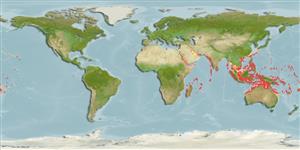Common names from other countries
>
Eupercaria/misc (Various families in series Eupercaria) >
Labridae (Wrasses) > Cheilininae
Etymology: Oxycheilinus: Greek, oxys = sharp + Greek, cheilos = lip.
More on author: Lacepède.
Environment: milieu / climate zone / depth range / distribution range
Ecologia
marinhas; estuarina associadas(os) a recifes; intervalo de profundidade 3 - 60 m (Ref. 90102). Tropical; 30°N - 23°S
Indo-Pacific: Red Sea and East Africa to the Marshall Islands and Samoa.
Tamanho / Peso / Idade
Maturity: Lm ? range ? - ? cm
Max length : 40.0 cm SL macho/indeterminado; (Ref. 9823)
Espinhos dorsais (total): 9; Raios dorsais moles (total): 10; Espinhos anais 3; Raios anais moles: 8 - 11. Differs from the very similar C. unifasciatus by always lacking the white bar in front of the caudal base as well as the area clear of red streaks extending from the eye to just above the pectoral axis (Ref. 1602).
Found solitary (Ref. 90102) in lagoon and sheltered seaward reefs in coral rich areas (Ref. 1602, 58652). Possibly to 120 m depths. Young is more inshore on sheltered reef crests or slopes, usually amongst soft corals or stinging hydrozoans (Ref. 48635). Feeds on hard-shelled mollusks, crustaceans, and sea urchins (Ref. 27550). The species is observed to swim with a group of goatfish and change its color to resemble these fish, it then darts out from the group to catch small fish (Ref. 2334). This species curiously approaches divers closely (Ref. 90102).
Life cycle and mating behavior
Maturidade | Reprodução | Desova | Ovos | Fecundidade | Larvas
Oviparous, distinct pairing during breeding (Ref. 205).
Randall, J.E., G.R. Allen and R.C. Steene, 1990. Fishes of the Great Barrier Reef and Coral Sea. University of Hawaii Press, Honolulu, Hawaii. 506 p. (Ref. 2334)
Categoria na Lista Vermelha da IUCN (Ref. 130435)
CITES (Ref. 128078)
Not Evaluated
Ameaça para o homem
Harmless
Utilização humana
Pescarias: pouco comercial; Aquário: Espécies comerciais
Mais informação
ReferênciasAquaculturaPerfil para aquaculturaEstirpesGenéticaElectrophoresesHereditariedadeDoençasProcessamentoMass conversion
Ferramentas
Relatórios especiais
Descarregue XML
Fontes da internet
Estimates based on models
Preferred temperature (Ref.
115969): 25.4 - 29.1, mean 28 (based on 910 cells).
Phylogenetic diversity index (Ref.
82804): PD
50 = 0.5020 [Uniqueness, from 0.5 = low to 2.0 = high].
Bayesian length-weight: a=0.01905 (0.01013 - 0.03584), b=2.95 (2.78 - 3.12), in cm Total Length, based on LWR estimates for this species & (Sub)family-body (Ref.
93245).
Nível Trófico (Ref.
69278): 3.7 ±0.4 se; based on diet studies.
Resiliência (Ref.
120179): Baixo, tempo mínimo de duplicação da população 4,5 - 14 anos (Preliminary K or Fecundity.).
Fishing Vulnerability (Ref.
59153): Moderate vulnerability (39 of 100).
